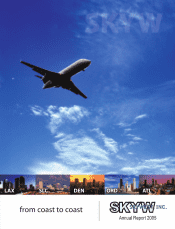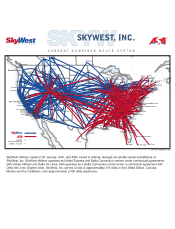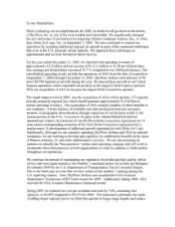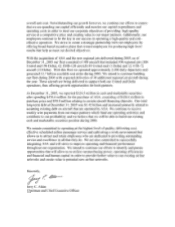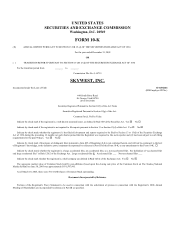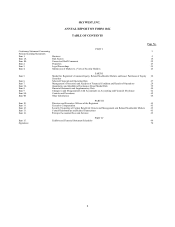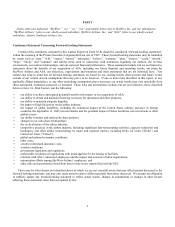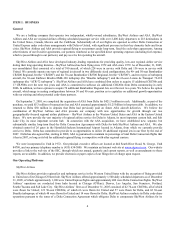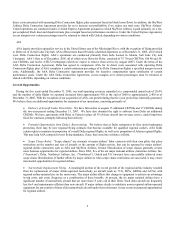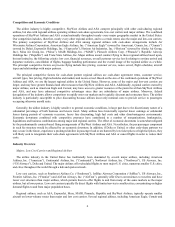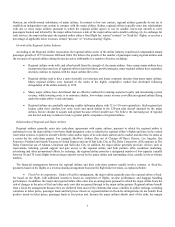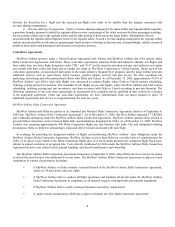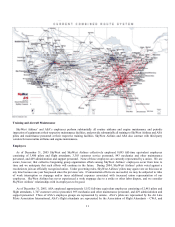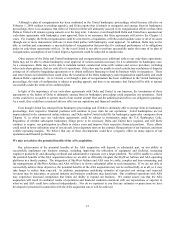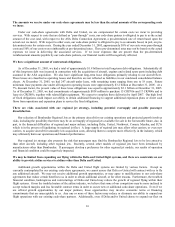SkyWest Airlines 2005 Annual Report Download - page 10
Download and view the complete annual report
Please find page 10 of the 2005 SkyWest Airlines annual report below. You can navigate through the pages in the report by either clicking on the pages listed below, or by using the keyword search tool below to find specific information within the annual report.6
Competition and Economic Conditions
The airline industry is highly competitive. SkyWest Airlines and ASA compete principally with other code-sharing regional
airlines, but also with regional airlines operating without code-share agreements, low-cost carriers and major airlines. The combined
operations of SkyWest Airlines and ASA extend nationally throughout nearly every major geographic market in the United States.
Our competition includes, therefore, nearly every other regional airline, and to a certain extent, also the major and low-cost carriers.
The primary competitors of SkyWest Airlines and ASA among regional airlines with code-share arrangements include Air
Wisconsin Airlines Corporation, American Eagle Airlines, Inc. (“American Eagle”) (owned by American), Comair, Inc. (“Comair”)
(owned by Delta), ExpressJet Holdings, Inc. (“ExpressJet”), Horizon Air Industries, Inc. (“Horizon”) (owned by Alaska Air Group,
Inc.), Mesa Air Group, Inc. (“Mesa”), MAIR Holdings, Inc. (“MAIR”), Pinnacle Airlines Corp. (“Pinnacle”), Republic Airways
Holdings Inc. (“Republic”) and Trans State Airlines, Inc. Major airlines award contract flying to these regional airlines based upon,
but not limited to, the following criteria: low cost, financial resources, overall customer service levels relating to on-time arrival and
departure statistics, cancellation of flights, baggage handling performance and the overall image of the regional airline as a whole.
The principal competitive factors on pro-rate flying include fare pricing, customer service, routes served, flight schedules, aircraft
types and relationships with major partners.
The principal competitive factors for code-share partner regional airlines are code-share agreement terms, customer service,
aircraft types, fare pricing, flight schedules and markets and routes served. Based on the size of the combined operations of SkyWest
Airlines and ASA, we are the largest regional airline in the United States. However, some of the major and low-cost carriers are
larger, and may have greater financial and other resources than SkyWest Airlines and ASA. Additionally, regional carriers owned by
major airlines, such as American Eagle and Comair, may have access to greater resources at the parent level than SkyWest Airlines
and ASA, and may have enhanced competitive advantages since they are subsidiaries of major airlines. Moreover, federal
deregulation of the industry allows competitors to rapidly enter our markets and to quickly discount and restructure fares. The airline
industry is particularly susceptible to price discounting because airlines incur only nominal costs to provide service to passengers
occupying otherwise unsold seats.
Generally, the airline industry is highly sensitive to general economic conditions, in large part due to the discretionary nature of a
substantial percentage of both business and leisure travel. Many airlines have historically reported lower earnings or substantial
losses during periods of economic recession, heavy fare discounting, high fuel costs and other disadvantageous environments.
Economic downturns combined with competitive pressures have contributed to a number of reorganizations, bankruptcies,
liquidations and business combinations among major and regional carriers. The effect of economic downturns is somewhat mitigated
by the predominantly contract-based flying arrangements of SkyWest Airlines and ASA. Nevertheless, the per passenger component
in such fee structure would be affected by an economic downturn. In addition, if Delta or United, or other code-share partners we
may secure in the future, experience a prolonged decline in passenger load or are harmed by low ticket prices or high fuel prices, they
will likely seek to renegotiate their code-share agreements with SkyWest Airlines and ASA or cancel flights in order to reduce their
costs.
Industry Overview
Majors, Low Cost Carriers and Regional Airlines
The airline industry in the United States has traditionally been dominated by several major airlines, including American
Airlines, Inc. (“American”), Continental Airlines, Inc. (“Continental”), Northwest Airlines, Inc. (“Northwest”), US Airways, Inc.
(“US Airways”), Delta and United. The major airlines offer scheduled flights to most major U.S. cities, numerous smaller U.S. cities,
and cities throughout the world through a hub and spoke network.
Low cost carriers, such as Southwest Airlines Co. (“Southwest”), JetBlue Airways Corporation (“JetBlue”), US Airways, Inc.,
Frontier Airlines, Inc. (“Frontier”) and AirTran Airways, Inc. (“AirTran”), generally offer fewer conveniences to travelers and have
lower cost structures than major airlines, which permits them to offer flights to and from many of the same markets as the major
airlines, but at lower prices. Low cost carriers typically fly direct flights with limited service to smaller cities, concentrating on higher
demand flights to and from major population bases.
Regional airlines, such as ASA, ExpressJet, Mesa, MAIR, Pinnacle, Republic and SkyWest Airlines, typically operate smaller
aircraft on lower-volume routes than major and low cost carriers. Several regional airlines, including American Eagle, Comair and

